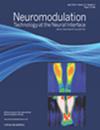具有无线低能量超声波功率和通信功能的新型闭环脑电刺激装置
IF 3.2
3区 医学
Q2 CLINICAL NEUROLOGY
引用次数: 0
摘要
研究目的:本研究旨在说明电神经调控系统原型的可行性:本研究旨在说明利用基于超声波的闭环节能机制进行通信、数据传输和充电的电神经调控系统原型的可行性:利用超声波宽带(UsWB)通信技术和小型化定制电子设备设计和制造了闭环脑深部刺激(DBS)原型。两台设备被短期植入麻醉的哥廷根小型猪(N = 2)体内。术前通过磁共振成像进行定位,术后通过计算机断层扫描确认位置。对 DBS 系统进行了广泛的刺激设置测试,以模拟最小、典型和/或激进的临床设置,并评估了其通过头皮组织传输数据的能力以及使用 UsWB 为 DBS 系统充电的能力:两名受试者都成功实现了振幅(1V-6V)、频率(50-250 Hz)和脉宽(60-200 μs)设置的刺激、通信、重新编程和充电协议,并维持了≥6小时。脉冲设置的精确度已通过结论验证:该系统的植入深度和设置均符合临床要求。在研究期间,该系统通过 4F 能量存储和完全快速充电实现了独立的双侧刺激。在未来的设计迭代中,通过采用特定应用集成电路级效率和 15F 储存电容,可将连续功能推断为六天的连续刺激。UsWB 提高了能源效率,降低了存储要求,从而实现了设备微型化。该设备可实现智能闭环刺激、远程系统监控和优化,并可作为电源/数据网关,将体内网络与医疗物联网互连。本文章由计算机程序翻译,如有差异,请以英文原文为准。
A Novel Closed-Loop Electrical Brain Stimulation Device Featuring Wireless Low-Energy Ultrasound Power and Communication
Objectives
This study aimed to indicate the feasibility of a prototype electrical neuromodulation system using a closed-loop energy-efficient ultrasound-based mechanism for communication, data transmission, and recharging.
Materials and Methods
Closed-loop deep brain stimulation (DBS) prototypes were designed and fabricated with ultrasonic wideband (UsWB) communication technology and miniaturized custom electronics. Two devices were implanted short term in anesthetized Göttingen minipigs (N = 2). Targeting was performed using preoperative magnetic resonance imaging, and locations were confirmed postoperatively by computerized tomography. DBS systems were tested over a wide range of stimulation settings to mimic minimal, typical, and/or aggressive clinical settings, and evaluated for their ability to transmit data through scalp tissue and to recharge the DBS system using UsWB.
Results
Stimulation, communication, reprogramming, and recharging protocols were successfully achieved in both subjects for amplitude (1V–6V), frequency (50–250 Hz), and pulse width (60–200 μs) settings and maintained for ≥six hours. The precision of pulse settings was verified with <5% error. Communication rates of 64 kbit/s with an error rate of 0.05% were shown, with no meaningful throughput degradation observed. Time to recharge to 80% capacity was <9 minutes. Two DBS systems also were implanted in the second test animal, and independent bilateral stimulation was successfully shown.
Conclusions
The system performed at clinically relevant implant depths and settings. Independent bilateral stimulation for the duration of the study with a 4F energy storage and full rapid recharge were achieved. Continuous function extrapolates to six days of continuous stimulation in future design iterations implementing application specific integrated circuit level efficiency and 15F storage capacitance. UsWB increases energy efficiency, reducing storage requirements and thereby enabling device miniaturization. The device can enable intelligent closed-loop stimulation, remote system monitoring, and optimization and can serve as a power/data gateway to interconnect the intrabody network with the Internet of Medical Things.
求助全文
通过发布文献求助,成功后即可免费获取论文全文。
去求助
来源期刊

Neuromodulation
医学-临床神经学
CiteScore
6.40
自引率
3.60%
发文量
978
审稿时长
54 days
期刊介绍:
Neuromodulation: Technology at the Neural Interface is the preeminent journal in the area of neuromodulation, providing our readership with the state of the art clinical, translational, and basic science research in the field. For clinicians, engineers, scientists and members of the biotechnology industry alike, Neuromodulation provides timely and rigorously peer-reviewed articles on the technology, science, and clinical application of devices that interface with the nervous system to treat disease and improve function.
 求助内容:
求助内容: 应助结果提醒方式:
应助结果提醒方式:


